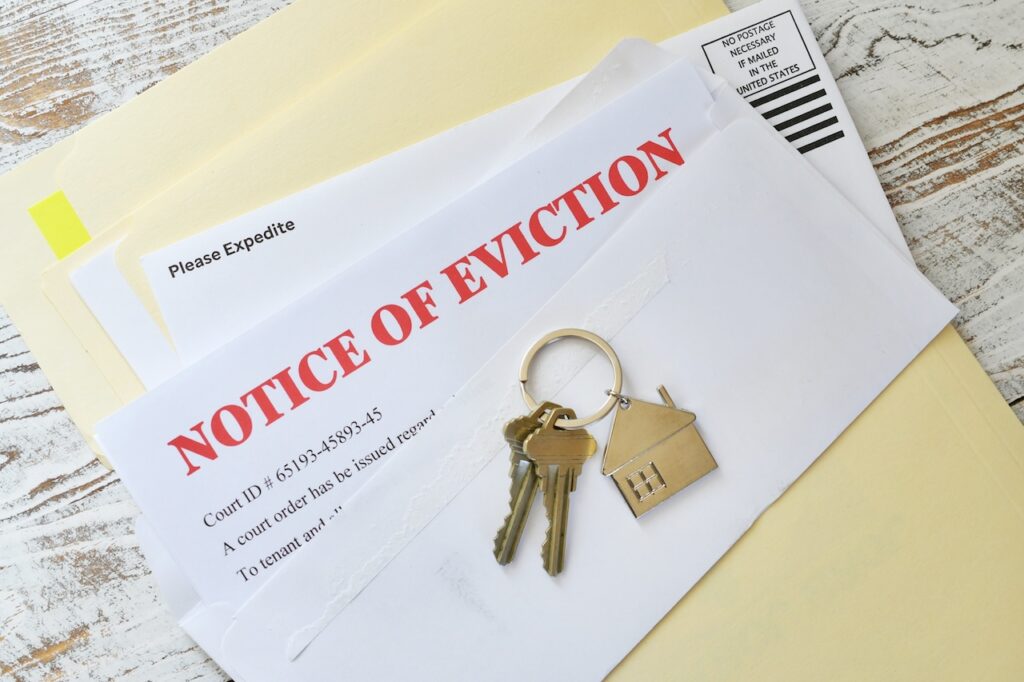Evictions aren’t something anyone wants to deal with, but they can become an unfortunate necessity in the world of property management. Whether you’re a landlord or a tenant, understanding the eviction process is crucial. It helps landlords manage their properties more effectively while ensuring tenants know their rights and responsibilities.
We are here to guide you through what you can expect from the eviction process, with a particular focus on California’s regulations since these regulations will vary per state. Let’s dive in!
Grounds for Eviction
Before we discuss the process, it’s essential to understand the grounds for eviction. In California, landlords can evict a tenant for several reasons, including:
- Nonpayment of rent
- Violation of lease terms or rental agreement
- Illegal activities on the property
- Refusal to leave after lease termination
It’s crucial to note that landlords cannot evict a tenant as an act of retaliation or discrimination.
The Eviction Process: Step by Step
Step 1: Serve Appropriate Notice
The first step in any eviction process is serving appropriate notice to the tenant. The type of notice required depends on the reason for eviction.
- Notice to Pay Rent or Quit: If the tenant has failed to pay rent, the landlord must serve a “Notice to Pay Rent or Quit.” The notice provides three days for the tenant to either pay the rent amount owed or vacate the premises.
- Notice to Cure or Quit: If the tenant has violated their lease agreement, such as having a pet when it’s prohibited, landlords can serve a “Notice to Cure or Quit.” This notice gives tenants three days to fix the violation or leave.
- Unconditional Notice to Quit: In cases of illegal activities on the property, landlords can serve an unconditional notice with no opportunity for the tenant to rectify their behavior. The notice gives the tenant three days to vacate the property.
- Notice of Termination of Tenancy: If a landlord wants to terminate a lease agreement, they must provide written notice 30 or 60 days in advance, depending on the length of the tenancy.
Step 2: Filing an Unlawful Detainer Lawsuit
If the tenant fails to comply with the appropriate notice, landlords can file an unlawful detainer lawsuit against them. This is a legal action that initiates the eviction process and requires tenants to appear in court.
Step 3: Serving Summons and Complaint
After filing an unlawful detainer lawsuit, landlords must serve tenants with a summons and complaint, which notifies them of the lawsuit and their right to respond.
Step 4: Tenant’s Response
Tenants have five days after being served with the summons and complaint to file a response. They can either contest or deny the allegations in the complaint or move out.
Step 5: Court Hearing
If the tenant fails to respond within five days, landlords can request a default judgment from the court. If tenants do respond, there will be a court hearing where both parties present their case.
Step 6: Writ of Possession
If the court rules in favor of the landlord, they will issue a writ of possession that allows the landlord to regain possession of the property. If the tenant still refuses to leave, landlords can request a sheriff or marshal to physically remove them from the property.
How Can Amanica Ease the Process for Property Managers?
Dealing with evictions can be overwhelming, but property management companies like Amanica can simplify the process. Amanica offers services that ensure property managers adhere to legal requirements and streamline communication between landlords and tenants. We help in the following ways:
- Advising on Legal Compliance: Amanica provides expert advice on the legal requirements surrounding evictions, ensuring that property managers follow the proper procedures to avoid legal pitfalls.
- Document Preparation: We assist in preparing all necessary documentation required for notices, summons, and court filings, making the process seamless for property managers.
- Tenant Communication: Our team facilitates clear communication between landlords and tenants, addressing concerns and minimizing misunderstandings.
By partnering with Amanica, property managers can navigate eviction with confidence, knowing that they have the support they need to achieve a fair and lawful resolution.
Understanding the Eviction Process in California
Whether you’re a landlord or a tenant, being informed about the eviction process can save time, money, and stress. Remember, it’s always beneficial to seek legal advice if you’re unsure about any aspect of the process.
By taking proactive steps and maintaining open communication, you can ensure a smoother experience for everyone involved.


